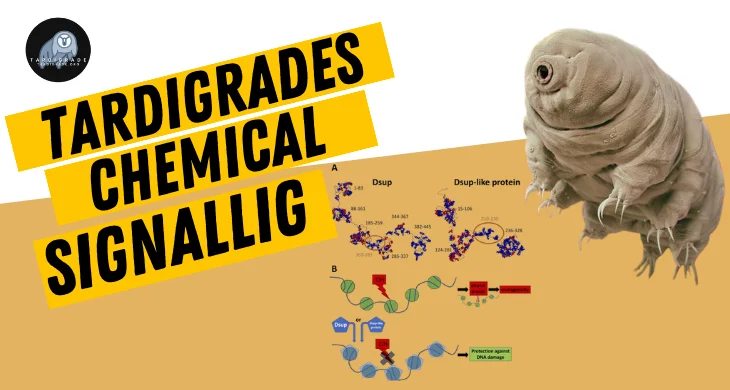Tardigrades, those resilient and minuscule wonders of the animal kingdom, have intrigued scientists and nature enthusiasts for decades. Known for their remarkable ability to endure extreme conditions, from the vacuum of space to scorching deserts, these microscopic creatures have a lot more to reveal. In this blog, we embark on a journey to uncover the hidden world of Tardigrade chemical signaling secrets.
The Tiny Titans of Resilience:
Tardigrades, those extraordinary microscopic creatures, are rightfully celebrated as the “tiny titans of resilience” in the natural world. Despite their minuscule size, they possess an array of remarkable qualities that allow them to thrive in some of the most challenging and inhospitable environments on Earth. Let’s explore what makes Tardigrades such extraordinary examples of adaptability and endurance.
Size and Appearance Tardigrades are truly tiny, typically ranging from 0.1 to 1.5 millimeters in length. These water-dwelling organisms, also known as “water bears” or “moss piglets,” have a unique and easily recognizable appearance. Their barrel-shaped bodies, often somewhat translucent, are encased in a protective cuticle. They have four pairs of stubby legs, each armed with tiny claws. Their appearance is reminiscent of armored miniature bears, a stark contrast to their actual size.
Habitats and Adaptability One of the most awe-inspiring aspects of Tardigrades is their adaptability. They can be found in a diverse array of environments, from the depths of the ocean to the highest mountaintops, and from the polar regions to the hottest deserts. Their resilience knows no bounds. They thrive in freshwater habitats like lakes and rivers, as well as in terrestrial environments, such as mosses, lichens, and leaf litter. Their ability to conquer such varied ecosystems underscores their adaptability and resourcefulness.
Remarkable Resilience Tardigrades are celebrated for their incredible resilience. They can withstand conditions that would be fatal to most other life forms. Extreme temperatures, whether scorching hot or freezing cold, do not deter them. They endure extreme pressures and intense radiation. When faced with desiccation (extreme drying), they enter a state of cryptobiosis, effectively pausing their metabolism and allowing them to survive for extended periods without water.
The Role of Cryptobiosis Cryptobiosis is a defining feature of Tardigrade resilience. It allows them to endure harsh environmental conditions by entering a state of suspended animation. In this dehydrated state, Tardigrades can withstand extreme desiccation and await more favorable conditions. It’s a survival strategy that showcases their adaptability and resourcefulness in the face of adversity.
Chemical Cues:
In the microscopic world inhabited by Tardigrades, where every moment is a battle for survival, the ability to detect and respond to chemical cues serves as a vital survival toolkit. These remarkable creatures, often referred to as “water bears” or “moss piglets,” rely on chemical signaling to navigate their environment, locate sustenance, identify potential mates, and adapt to ever-changing circumstances. In this blog, we’ll unravel the significance of chemical cues in the lives of Tardigrades.
Navigating the Microscopic World Tardigrades live in a world where every drop of water contains its own universe of microorganisms and organic matter. With a size range of 0.1 to 1.5 millimeters, they must be adept at navigating this microscopic realm. Chemical cues provide them with a crucial sensory tool, allowing them to perceive their surroundings and make critical decisions.
The Sensory Structures: Fine-Tuned for Detection Tardigrades possess specialized sensory structures, often concentrated around their mouthparts, that are fine-tuned for chemical reception. These structures enable them to detect various chemical cues in their environment. While the precise mechanisms of these sensory organs are still subjects of scientific study, they play an essential role in helping Tardigrades interpret the chemical information around them.
Assessing Conditions One of the primary functions of chemical cues is to help Tardigrades assess environmental conditions. They can detect cues that signal the availability of food, moisture levels, and the presence of potential threats. This information allows them to make informed decisions about where to forage, when to enter cryptobiosis (a state of suspended animation), and when to be on alert for danger.
Mating Behavior: Chemical Signaling in Reproduction Chemical cues are intricately tied to Tardigrade mating behavior. Tardigrades release chemical cues to communicate their readiness to mate. These cues play a vital role in synchronizing the reproductive activities of potential mates. The precise chemical signals used in these rituals continue to be a subject of scientific exploration.
Adaptive Responses to Environmental Changes Tardigrades also use chemical cues to adapt to environmental changes. When faced with unfavorable conditions, they can perceive cues signaling the onset of desiccation or extreme temperatures. These cues prompt them to enter cryptobiosis, a state that enables them to survive until more favorable circumstances return.
Sensory Structures:
In the intricate world of Tardigrades, where survival hinges on the ability to perceive and respond to the subtlest of cues, sensory structures play a pivotal role. These remarkable microorganisms, often referred to as “water bears” or “moss piglets,” possess finely tuned sensory structures that enable them to navigate the microscopic realm with precision. In this blog, we delve into the fascinating world of Tardigrade sensory structures and their role in helping these tiny creatures thrive.
A Microscopic Universe For Tardigrades, the microscopic universe in which they reside is a complex and often perilous environment. Every drop of water contains a myriad of potential food sources, predators, and other microorganisms. In this world, being able to accurately sense their surroundings is a matter of life and death.
Specialized Sensory Organs Tardigrades have evolved specialized sensory structures that are concentrated around their mouthparts. These structures are fine-tuned for chemical reception, allowing Tardigrades to detect and respond to chemical cues in their environment. While the precise mechanisms behind these sensory organs are still a subject of scientific investigation, their importance in helping Tardigrades interpret the chemical information in their surroundings cannot be overstated.
Assessing Environmental Conditions The primary function of these sensory structures is to help Tardigrades assess environmental conditions. They can detect chemical cues that signal the availability of food, moisture levels, and the presence of potential threats. This information empowers them to make informed decisions about where to forage, when to enter cryptobiosis (a state of suspended animation), and when to be vigilant for danger.
Unveiling Nature’s Hidden Secrets:
In the realm of nature’s hidden secrets, few creatures rival the enigmatic Tardigrades, often affectionately called “water bears” or “moss piglets.” These microcosmic wonders are renowned for their astonishing resilience and the ability to survive in some of the harshest environments on Earth. As we delve into the world of Tardigrade resilience, we uncover the remarkable hidden secrets of nature.
The Lilliputian Titans of Survival Tardigrades, though barely visible to the naked eye, are true giants when it comes to resilience. Their diminutive size, typically ranging from 0.1 to 1.5 millimeters, belies their capacity to withstand extreme conditions that would be fatal to most other life forms. They are the tiny titans of survival, enduring temperature extremes, radiation, and even the vacuum of space.
Cryptobiosis: The Art of Suspended Animation One of the most intriguing secrets in the Tardigrade’s survival toolkit is cryptobiosis. When confronted with adverse conditions, such as extreme drying or freezing, Tardigrades can enter a state of suspended animation. In this dehydrated form, they effectively pause their metabolism and endure harsh conditions until a more hospitable environment reemerges.
A Symphony of Survival Mechanisms Tardigrades rely on a symphony of survival mechanisms to thrive. They are experts at withstanding extreme temperatures, enduring high pressures, and even repairing their damaged DNA. Their adaptability to diverse environments, from the deep sea to mountain peaks, is a testament to the versatility of life on our planet.
Inspiration for Science and Beyond Tardigrades are of significant scientific interest, not just for their resilience but for the potential applications in various fields. Their ability to endure extreme conditions has implications for astrobiology, biotechnology, and environmental studies. They inspire researchers to explore the boundaries of life’s adaptability, both on Earth and beyond.
The Cryptobiosis Connection:
In the intricate web of nature’s survival strategies, few are as intriguing as the cryptobiosis connection in Tardigrades. These microscopic wonders, often fondly known as “water bears” or “moss piglets,” have mastered the art of cryptobiosis, a survival strategy that allows them to endure harsh environmental conditions.
A State of Suspended Animation Cryptobiosis is a state of suspended animation, a term that seems more suited to science fiction than to the natural world. Yet, Tardigrades are true masters of this biological feat. When faced with unfavorable conditions, such as extreme drying, freezing, or exposure to radiation, Tardigrades enter cryptobiosis. In this state, they effectively shut down their metabolism, allowing them to survive in a dehydrated form until conditions improve.
The Art of Survival Cryptobiosis is, in many ways, the art of survival for Tardigrades. It is a remarkable adaptation that enables them to endure the harshest of environments. Whether it’s the vacuum of space, the extreme cold of the Antarctic, or the desiccation of a desert, Tardigrades can persist, often for years, until conditions become more favorable.
A Protective Shield: Trehalose At the heart of the cryptobiosis connection is trehalose, a sugar molecule that acts as a protective shield for Tardigrades. As these creatures dehydrate and enter suspended animation, trehalose replaces water in their cells, preventing damage to biological structures. This sugar serves as a safeguard, ensuring that Tardigrades can reanimate when conditions improve.
Resilience in the Face of Adversity The cryptobiosis connection exemplifies the resilience of Tardigrades. Instead of succumbing to harsh conditions, they adapt and persevere. Cryptobiosis allows them to delay reproduction, conserve energy, and endure challenges that would be insurmountable for many other organisms.
FAQS:
Q1: What are Tardigrades?
A1: Tardigrades are microscopic, water-dwelling animals known for their remarkable resilience in extreme conditions.
Q2: What is chemical signaling in Tardigrades?
A2: Chemical signaling refers to the ability of Tardigrades to detect and respond to chemical cues in their environment. They use this to assess conditions, locate food, identify mates, and adapt to changing circumstances.
Q3: How do Tardigrades detect chemical cues?
A3: Tardigrades have specialized sensory structures that allow them to detect chemical cues. These structures are typically concentrated around their mouthparts.
Q4: What role does chemical signaling play in Tardigrade mating behavior?
A4: Chemical signaling is crucial for Tardigrade mating behavior. They release chemical cues to communicate their readiness to mate, which is vital for synchronizing their reproductive activities.
Q5: How do Tardigrades use chemical signaling in their survival strategies?
A5: Tardigrades can detect environmental cues, such as desiccation or extreme temperatures, through chemical signaling. This helps them enter cryptobiosis, a state of suspended animation, to survive harsh conditions.
Q6: Why are Tardigrades of scientific interest in terms of chemical signaling?
A6: Tardigrades are of scientific interest because they showcase how organisms can adapt and thrive in challenging environments by using chemical signaling. Their unique abilities have practical applications in various fields, from biology to biotechnology.
Conclusion:
In the microscopic realm, where life takes on dimensions unseen by the naked eye, Tardigrades stand as exceptional ambassadors of adaptability and resilience. These tiny, water-dwelling creatures, often playfully called “water bears” or “moss piglets,” have a fascinating secret hidden in the language of chemicals. Their ability to detect, respond to, and communicate through chemical signaling is a testament to the intricate mechanisms of life on our planet.
Tardigrades utilize chemical cues as a survival toolkit, allowing them to assess the conditions of their surroundings, locate sustenance, identify potential mates, and even avoid harm. This remarkable ability doesn’t merely serve as a curiosity but underscores their capacity to adapt to ever-changing environments.

